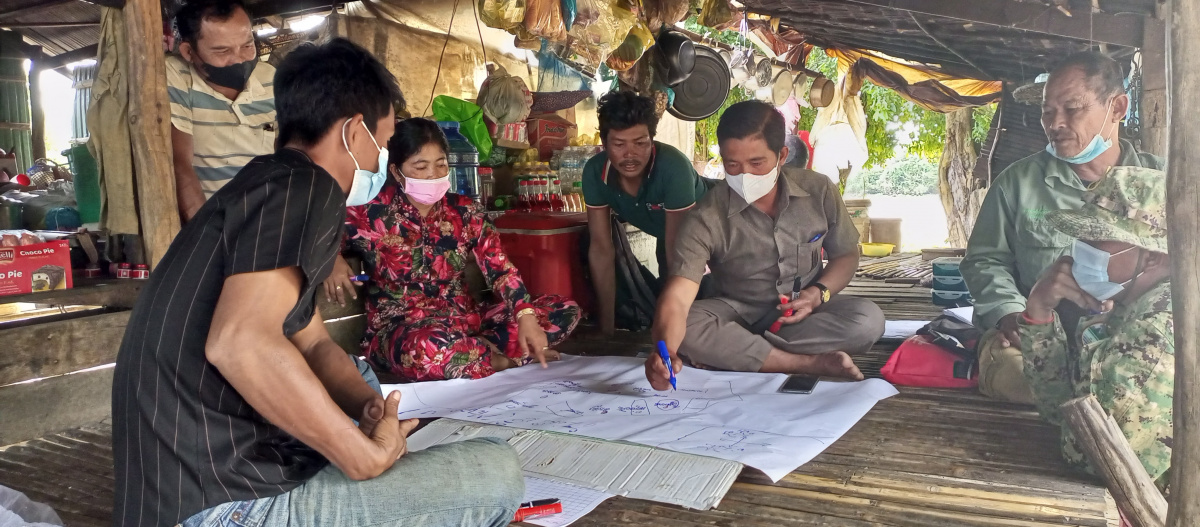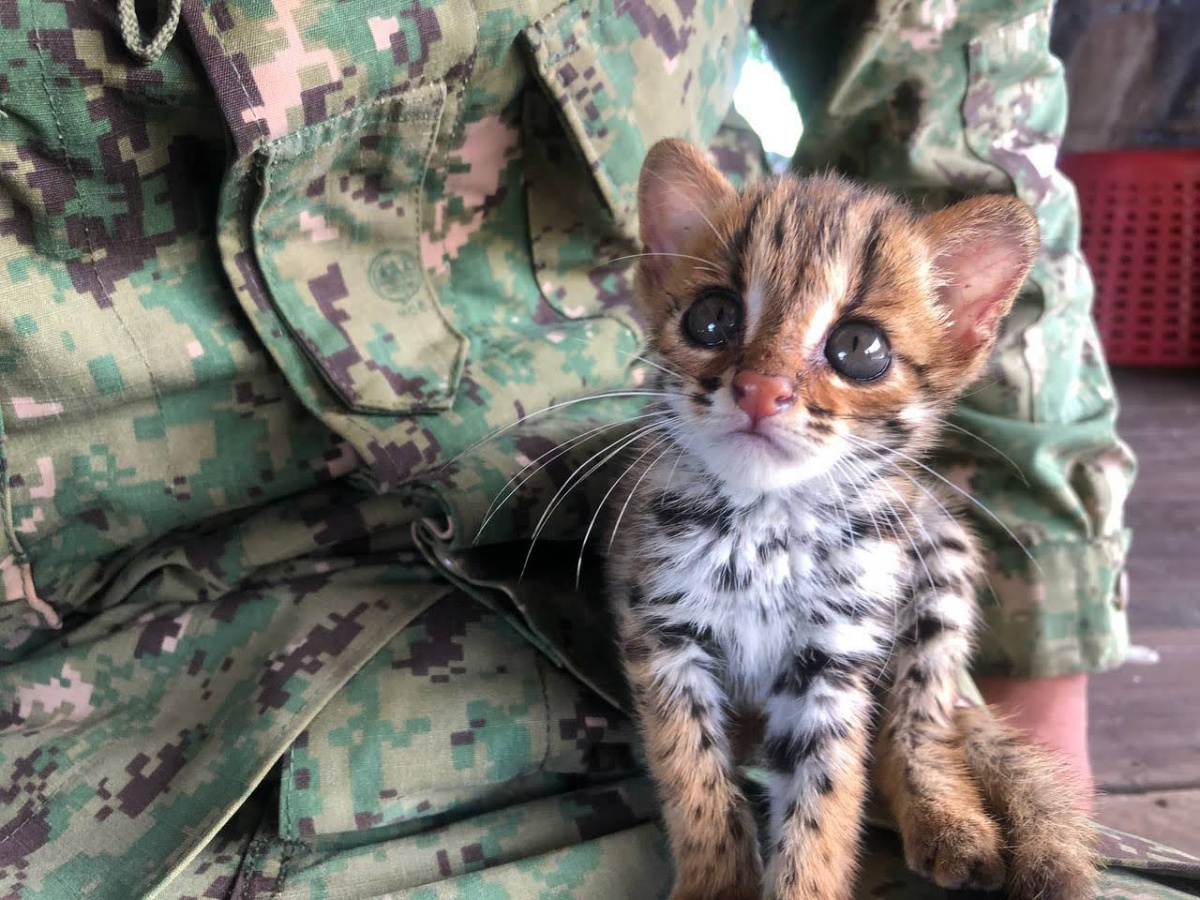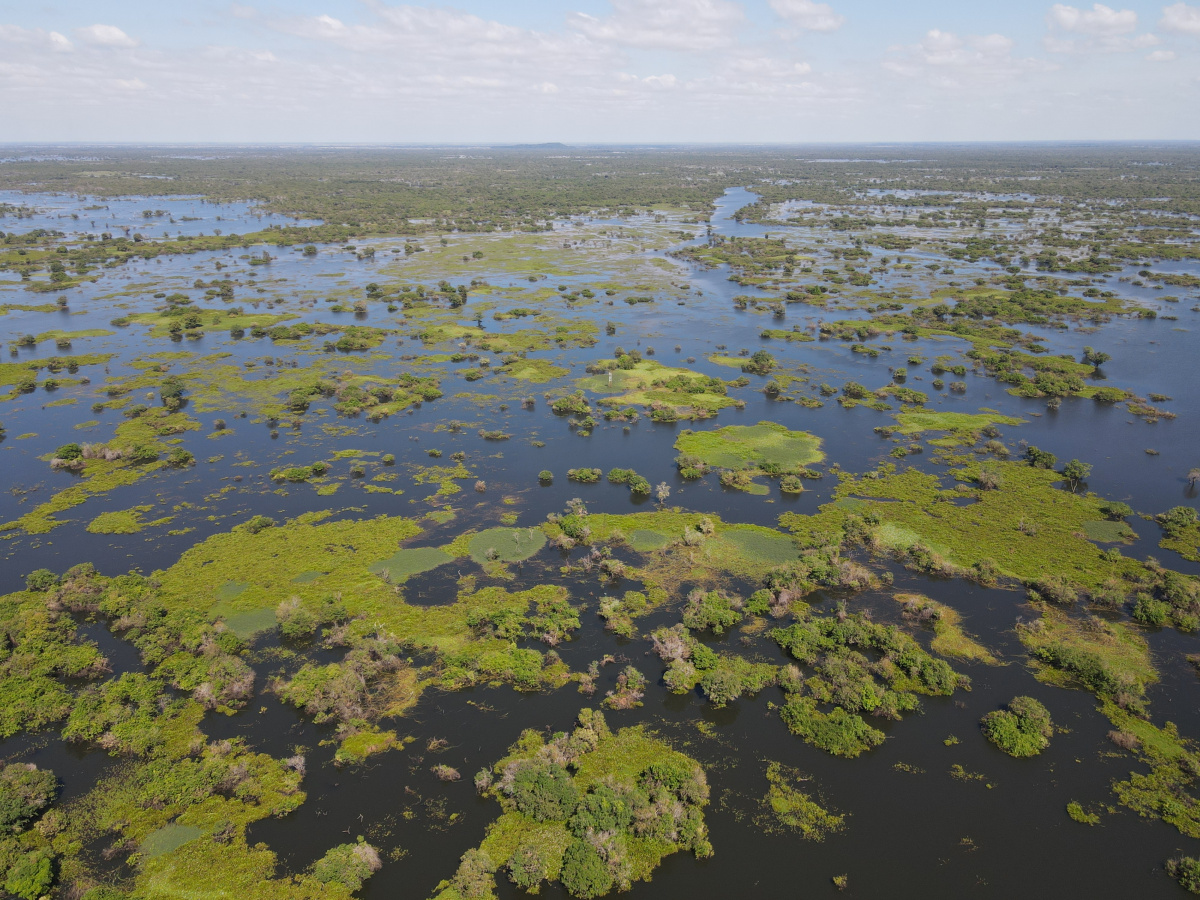Climate change anticipated to intensify threats to unique flooded forest in Stung Sen Ramsar Site, Cambodia
Throughout 2021, the Fishing Cat Ecological Enterprise (FCEE) conducted biodiversity surveys and camera-trapping in Stung Sen Ramsar Site (SSRS), and used the IUCN Mekong WET Climate Change Vulnerability Assessment (CCVA) to understand the vulnerability of the wetland through interviews with local community members. The project also began implementing conservation actions to prevent and mitigate the impact of forest fires by building a watch tower to establish an early warning system.
FCEE conducted key informant interviews and small focus group discussions to investigate climate change vulnerability within the Ramsar site. Initial findings suggest an increase in frequency and intensity of extreme weather events such as storms and strong winds, as well as changes in rain patterns and increases in temperatures. Furthermore, local community members reported that over the last three years, flood patterns have been heavily impacted by the restriction of water flow in the Mekong River, and floods have been substantially delayed, lasting for much shorter periods and with significantly lower water levels, heavily impacting fish catch and local livelihoods.
Throughout the course of the project, FCEE collaborated with a very active local community conservation initiative, Toul Neang Sav-Phlov Loung Community Protected Area committee (CPA), which has been working with NatureLife Cambodia / Birdlife International (NatureLife) to protect an important portion of SSRS and significant areas of adjacent flooded forest. FCEE, the CPA committee and NatureLife discussed options for forest fire prevention and mitigation, and it was decided that the most effective measure would be the construction of a watch tower at a priority site in the area overlapping SSRS and the CPA. Members of the CPA provided their own design for the tower, which will be constructed with financial support from IUCN Mekong WET and Fishing Cat Conservation Alliance (FCCA) during 2022.
FCEE also took an innovative approach to validate the recommendations stemming from the initial results of the climate change vulnerability assessment; a simple methodology was provided to CPA members to work with the local community and conduct validation workshops, and thus feel free to discuss issues and options. The results of the validation workshops indicate that local communities are interested in applying Nature-based Solutions, such as habitat restoration, to enhance resilience to climate change and control the spread of invasive species such as Mimosa pigra, water hyacinth (Pontederia crassipes) and golden apple snail (Pomacea canaliculata) to reduce ecosystem degradation.
“Stung Sen Ramsar site hosts substantial areas of flooded forest habitat, which is essential for the survival of many globally threatened species, and is a rare ecosystem storing huge amounts of irrecoverable carbon (as recently defined in an article published in Nature). The site is under threat from decreased and shortened wet season floods due to upstream water infrastructure operations on the Mekong, land encroachment, invasive species and forest fires, and our assessment found it is also considerably vulnerable to climate change, which will intensify the impact of other threats,” said Vanessa Herranz Muñoz, Conservation Zoologist and Director of FCEE.
The research team also conducted camera trapping surveys at the site, documenting the presence of significant populations of endangered hairy-nosed otters (Lutra sumatrana) and endangered Indochinese silvered langurs (Trachypithecus germaini) living within and around SSRS. Local community members use the Khmer name for the fishing cat (Prionailurus viverrinus), kla trey, literally “fishing tiger,” mainly to identify the smaller leopard cat (Prionailurus bengalensis), and only a few people had ever seen the “big one” or the “mother of the fishing cat,” which are local names given to the actual fishing cat. “Although we haven’t yet recorded fishing cat presence in Stung Sen, we believe that the species still exists in the area and we’ll continue our survey over the coming months to search for the elusive feline,” said Herranz Muñoz.
Though surveys have not yet shown any fishing cats in SSRS, leopard cats are relatively common, utilizing remote areas of flooded forest. Leopard cats are not strong swimmers like fishing cats, and sometimes kittens fall in the water and are rescued from drowning by local community members. In December 2021, FCEE, Ministry of Environment rangers and CPA members facilitated the donation of two rescued leopard cat kittens, to be rehabilitated at Phnom Tamao Rescue Center and eventually released, with FCEE assisting their return to the natal SSRS flooded forests.
Stung Sen is located at the southeastern edge of the Tonle Sap Lake, and is comprised of seasonal floodplain, harboring significant areas of flooded forests, gallery forests and flooded grasslands. SSRS provides essential breeding habitat for many fish species, including critically endangered species such as Jullien’s golden carp (Probarbus jullieni), and giant carp (Catlocarpio siamensis). In addition, globally threatened mammals such as endangered hairy-nosed otters and Indochinese silvered langurs, as well as water birds such as the near threatened spot-billed pelican and Asian openbill also depend on Stung Sen and its floodplain for foraging and breeding habitats.
The study found that Stung Sen Ramsar Site, its flooded forests habitats, and the wildlife and people that depend on them for their survival face severe threats from climate change, with impacts on highly vulnerable species, habitats and local livelihoods. FCEE will continue working with local stakeholders to reduce threats, protect wildlife and implement climate change adaptation actions in this important wetland.
About MWET
Funded by the International Climate Initiative (IKI) of the German Federal Ministry for the Environment, Nature Conservation, Building and Nuclear Safety (BMUB), the “Mekong WET: Building Resilience of Wetlands in the Lower Mekong Region” project aims to build climate resilience by harnessing the benefits of wetlands in Cambodia, Lao PDR, Thailand, and Viet Nam.
Mekong WET will help the four countries to address their commitments to the Ramsar Convention, an international treaty for the conservation and sustainable use of wetlands, and to achieve the Aichi Biodiversity Targets.
About IBRRI
The Indo-Burma Ramsar Regional Initiative (IBRRI) was jointly developed by the Ramsar National Focal Points of the five countries (Cambodia, Lao PDR, Myanmar, Thailand, and Viet Nam), and IUCN’s Asia Regional Office, based on specific needs identified in these countries. It was endorsed by the 52nd meeting of the Ramsar Convention Standing Committee in June 2016. The IBRRI aims to support the coordinated implementation of the objectives of the Strategic Plan of the Ramsar Convention. IUCN acts as the Secretariat for the Initiative under the leadership of the Steering Committee, which includes representatives from the five governments and the Ramsar Convention Secretariat as an observer.







